KitchenAid KDRS463VSS04, KDRS463VSD01, KDRS463VMW01, KDRS463VBU01, KDRS463VBK01 Owner’s Manual
...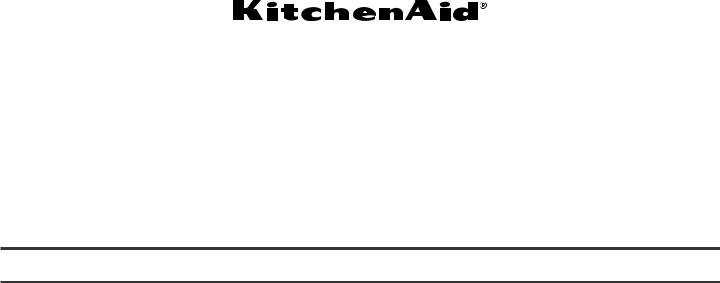
COMMERCIAL-STYLE DUAL FUEL
CONVECTION RANGES USE AND CARE GUIDE
CUISINIÈRES À CONVECTION À
BI-COMBUSTIBLE DE STYLE COMMERCIAL GUIDE D’UTILISATION ET D’ENTRETIEN
Para una versión de estas instrucciones en español, visite www.kitchenaid.com.
For questions about features, operation/performance, parts, accessories or service, call: 1-800-422-1230 or visit our website at www.kitchenaid.com.
In Canada, for assistance, installation and service, call: 1-800-807-6777 or visit our website at www.kitchenaid.ca.
Au Canada, pour assistance, installation ou service composez le 1-800-807-6777 ou visitez notre site web à www.kitchenaid.ca.
W11090447A
SP: W11093282

Table of Contents |
|
SAFETY INFORMATION................................................................. |
3 |
The Anti-Tip Bracket.......................................................... |
4 |
PARTS AND FEATURES................................................................. |
6 |
Range................................................................................. |
6 |
Oven Interior...................................................................... |
6 |
Electronic Oven Controls................................................... |
7 |
COOKTOP FEATURES...................................................................8 |
Burners..............................................................................8 |
Grill.....................................................................................9 |
Chrome Electric Griddle..................................................10 |
USING YOUR OVEN.....................................................................11 |
Control Panel...................................................................11 |
Oven Display....................................................................11 |
Functions.........................................................................11 |
Options............................................................................12 |
Know Your Oven..............................................................15 |
Traditional Cooking..........................................................17 |
Special Modes.................................................................20 |
CARE AND CLEANING.................................................................22 |
Cooktop Surface.............................................................22 |
Sealed Surface Burners...................................................22 |
Porcelain-Coated Grates and Caps................................23 |
Grill...................................................................................23 |
Griddle.............................................................................25 |
Cooktop Controls............................................................26 |
Stainless Steel.................................................................26 |
Control Panel...................................................................27 |
Door Exterior....................................................................27 |
Door Interior.....................................................................27 |
Oven Racks.....................................................................27 |
Oven Cavity.....................................................................27 |
Self-Cleaning the Oven...................................................28 |
Oven Lights......................................................................29 |
TROUBLESHOOTING...................................................................30 |
ASSISTANCE OR SERVICE.......................................................... |
32 |
ACCESSORIES.............................................................................. |
32 |
WARRANTY................................................................................... |
33 |
Table des matières |
|
INFORMATIONS DE SÉCURITÉ.................................................. |
34 |
Le pied antibasculement................................................. |
35 |
PIÈCES ET CARACTÉRISTIQUES............................................... |
37 |
Cuisinière......................................................................... |
37 |
Intérieur du four................................................................ |
37 |
Commandes électroniques du four................................. |
38 |
CARACTÉRISTIQUES DE LA TABLE DE CUISSON.................. |
39 |
Brûleurs............................................................................ |
39 |
Grill................................................................................... |
40 |
Plaque à frire électrique chromée................................... |
41 |
UTILISATION DU FOUR................................................................ |
42 |
Tableau de commande.................................................... |
42 |
Affichage du four............................................................. |
42 |
Fonctions......................................................................... |
42 |
Options............................................................................. |
44 |
Se familiariser avec le four............................................... |
47 |
Cuisson traditionelle........................................................ |
49 |
Modes spéciaux............................................................... |
52 |
ENTRETIEN ET NETTOYAGE...................................................... |
55 |
Surface de la table de cuisson........................................ |
55 |
Brûleurs de surface scelles.............................................. |
55 |
Grilles et chapeaux emailles............................................ |
56 |
Gril.................................................................................... |
56 |
Plaque à frire.................................................................... |
58 |
Commandes de la table de cuisson................................ |
59 |
Acier inoxydable.............................................................. |
59 |
Tableau de commande.................................................... |
60 |
Extérieur de la porte........................................................ |
60 |
Intérieur de la porte.......................................................... |
60 |
Grilles de four................................................................... |
60 |
Cavité du four.................................................................. |
60 |
Autonettoyage du four..................................................... |
61 |
Lampes du four................................................................ |
62 |
DÉPANNAGE................................................................................. |
63 |
ASSISTANCE OU SERVICE.......................................................... |
65 |
ACCESSOIRES.............................................................................. |
65 |
GARANTIE..................................................................................... |
66 |
2
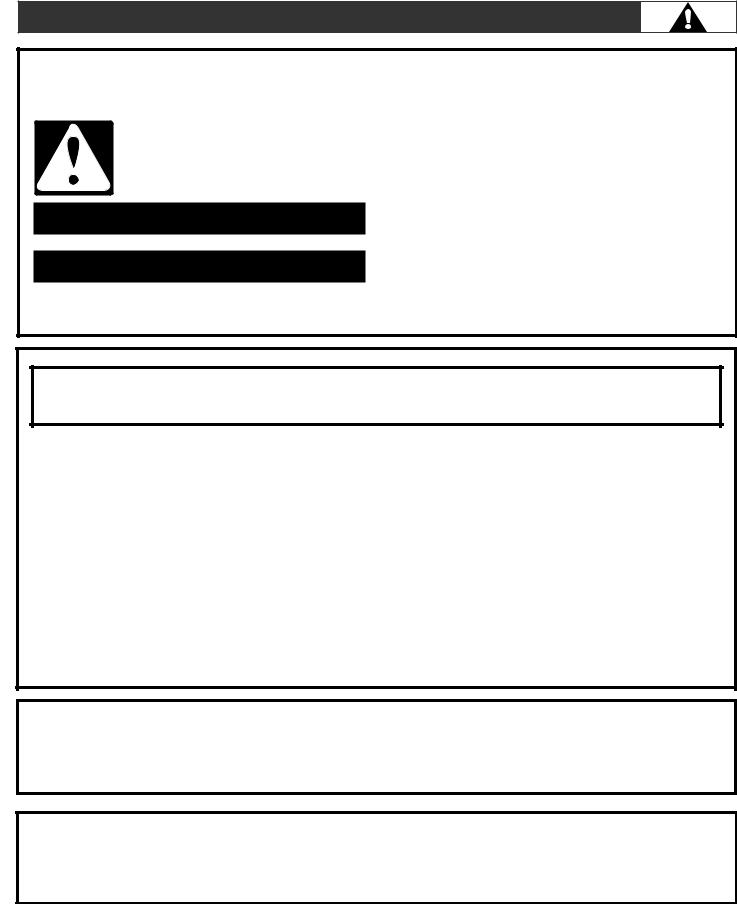
SAFETY INFORMATION
Your safety and the safety of others are very important.
many important safety messages in this manual and on your appliance. Always read and obey all safety
safety alert symbol.
alerts you to potential hazards that can kill or hurt you and others.
messages will follow the safety alert symbol and either the word “DANGER” or “WARNING.” mean:
 DANGER
DANGER  WARNING
WARNING
You can be killed or seriously injured if you don't immediately follow instructions.
You can be killed or seriously injured if you don't follow instructions.
All safety messages will tell you what the potential hazard is, tell you how to reduce the chance of injury, and tell you what can happen if the instructions are not followed.
WARNING: If the information in these instructions is not followed exactly, a fire or explosion may result causing property damage, personal injury or death.
–Do not store or use gasoline or other flammable vapors and liquids in the vicinity of this or any other appliance.
–WHAT TO DO IF YOU SMELL GAS:
•Do not try to light any appliance.
•Do not touch any electrical switch.
•Do not use any phone in your building.
•Immediatelyinstructions.call your gas supplier from a neighbor's phone. Follow the gas supplier's
•If you cannot reach your gas supplier, call the fire department.
–Installation and service must be performed by a qualified installer, service agency or the gas supplier.
WARNING: Gas leaks cannot always be detected by smell.
Gas suppliers recommend that you use a gas detector approved by UL or CSA.
For more information, contact your gas supplier.
If a gas leak is detected, follow the “What to do if you smell gas” instructions.
State of California Proposition 65 Warnings:
WARNING: This product contains one or more chemicals known to the State of California to cause cancer.
WARNING: This product contains one or more chemicals known to the State of California to cause birth defects or other reproductive harm.
3
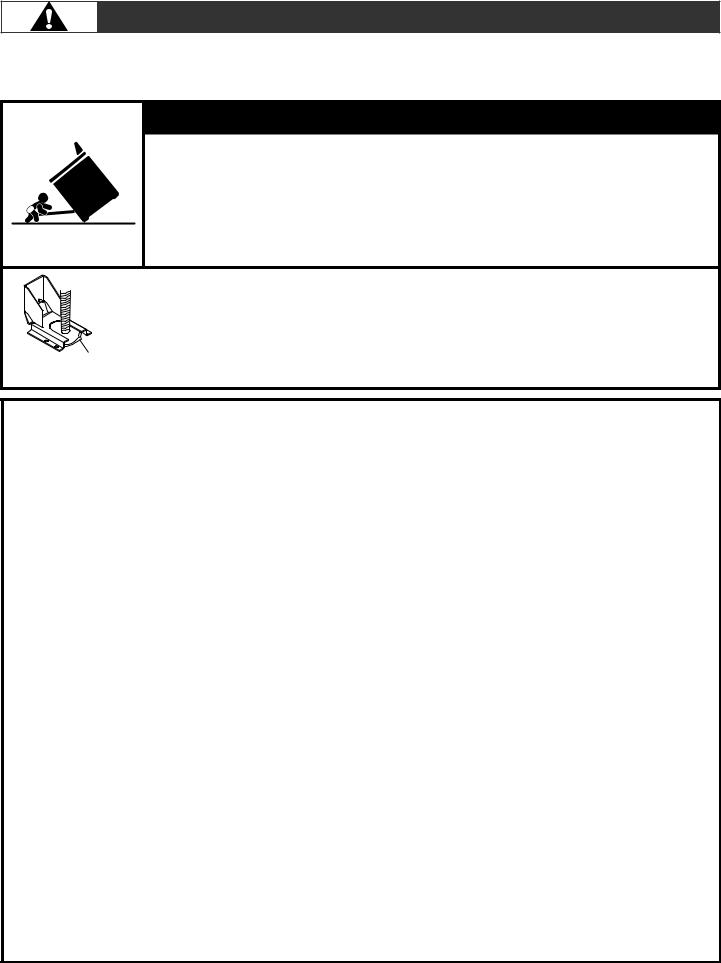
SAFETY INFORMATION
THE ANTI-TIP BRACKET
The range will not tip during normal use. However, the range can tip if you apply too much force or weight to the open door without the anti-tip bracket fastened down properly.
 WARNING
WARNING
Tip Over Hazard A child or adult can tip the range and be killed.
Verify the anti-tip bracket has been properly installed and engaged per installation instructions. Re-engage the anti-tip bracket if the range is moved.
Do not operate range without anti-tip bracket installed and engaged.
Failure to follow these instructions can result in death or serious burns to children and adults.
Anti-Tip
 Bracket
Bracket
Range Foot
To verify the anti-tip bracket is installed and engaged:
•Slide range forward.
•Look for the anti-tip bracket securely attached to floor or wall.
•Slide range back so rear range foot is under anti-tip bracket.
•See installation instructions for details.
IMPORTANT SAFETY INSTRUCTIONS
WARNING: To reduce the risk of fire, electrical shock, injury to persons, or damage when using the range, follow basic precautions, including the following:
■ WARNING: TO REDUCE THE RISK OF TIPPING OF THE RANGE, THE RANGE MUST BE SECURED BY PROPERLY INSTALLED ANTI-TIP DEVICES. TO CHECK IF THE DEVICES ARE INSTALLED PROPERLY, SLIDE RANGE FORWARD, LOOK FOR ANTI-TIP BRACKET SECURELY ATTACHED TO FLOOR OR WALL, AND SLIDE RANGE BACK SO REAR RANGE FOOT IS UNDER ANTI-TIP BRACKET.
■ WARNING: TO REDUCE THE RISK OF BURNS, DO NOT MOVE THE RANGE WHILE HOT. THIS RANGE IS PROVIDED WITH WHEELS TO FACILITATE MOVEMENT. TO REDUCE THE RISK OF INJURY DUE TO TIPPING OF THE APPLIANCE, VERIFY THE REINSTALLATION OF THE RANGE INTO THE ANTI-TIP DEVICE PROVIDED, AND EXTEND LEVELING FEET AFTER RETURNING THE RANGE TO THE ORIGINAL INSTALLED POSITION.
■ WARNING: NEVER use this appliance as a space heater to heat or warm the room. Doing so may result in carbon monoxide poisoning and overheating of the oven.
■ WARNING: NEVER cover any slots, holes or passages in the oven bottom or cover an entire rack with materials such as aluminum foil. Doing so blocks air flow through the oven and may cause carbon monoxide poisoning. Aluminum foil linings may also trap heat, causing a fire hazard.
■ CAUTION: Do not store items of interest to children in cabinets above a range or on the backguard of a range – children climbing on the range to reach items could be seriously injured.
■Do Not Leave Children Alone – Children should not be left alone or unattended in area where the range is in use. They should never be allowed to sit or stand on any part of the range.
■Wear Proper Apparel – Loose-fitting or hanging garments should never be worn while using the range.
■User Servicing – Do not repair or replace any part of the range unless specifically recommended in the manual. All other servicing should be referred to a qualified technician.
■Storage in or on the Range – Flammable materials should not be stored in an oven or near surface units.
■Do Not Use Water on Grease Fires – Smother fire or flame or use dry chemical or foam-type extinguisher.
■Use Only Dry Potholders – Moist or damp potholders on hot surfaces may result in burns from steam. Do not let potholder touch hot heating elements. Do not use a towel or other bulky cloth.
■DO NOT TOUCH SURFACE UNITS OR AREAS NEAR UNITS – Surface units may be hot even though they are dark in color. Areas near surface units may become hot enough to cause burns. During and after use, do not touch, or let clothing or other flammable materials contact surface units or areas near units until they have had sufficient time to cool. Among those areas are the cooktop and surfaces facing the cooktop.
■Never Leave Surface Units Unattended at High Heat Settings – Boilover causes smoking and greasy spillovers that may ignite.
■Glazed Cooking Utensils – Only certain types of glass, glass/ceramic, ceramic, earthenware, or other glazed utensils are suitable for range-top service without breaking due to the sudden change in temperature.
SAVE THESE INSTRUCTIONS
4
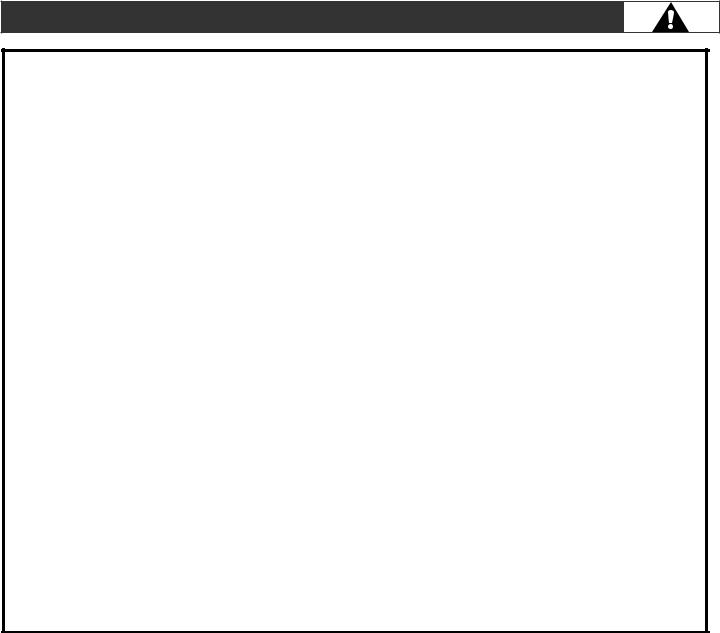
SAFETY INFORMATION
IMPORTANT SAFETY INSTRUCTIONS
■Utensil Handles Should Be Turned Inward and Not Extend Over Adjacent Surface Units – To reduce the risk of burns, ignition of flammable materials, and spillage due to unintentional contact with the utensil, the handle of a utensil should be positioned so that it is turned inward, and does not extend over adjacent surface units.
■Clean Cooktop With Caution – If a wet sponge or cloth is used to wipe spills on a hot cooking area, be careful to avoid steam burn. Some cleaners can produce noxious fumes if applied to a hot surface.
■Use Care When Opening Door – Let hot air or steam escape before removing or replacing food.
■Do Not Heat Unopened Food Containers – Build-up of pressure may cause container to burst and result in injury.
■Keep Oven Vent Ducts Unobstructed.
■Placement of Oven Racks – Always place oven racks in desired location while oven is cool. If rack must be moved while oven is hot, do not let potholder contact hot heating element in oven.
■DO NOT TOUCH HEATING ELEMENTS OR INTERIOR SURFACES OF OVEN – Heating elements may be hot even though they are dark in color. Interior surfaces of an oven become hot enough to cause burns. During and after use, do not touch, or let clothing or other flammable materials contact heating elements or interior surfaces of oven until they have had sufficient time to cool. Other surfaces of the appliance may become hot enough to cause burns – among these surfaces are oven vent openings and surfaces near these openings, oven doors, and windows of oven doors.
■Proper Installation – The range, when installed, must be electrically grounded in accordance with local codes or, in the absence of local codes, with the National Electrical Code, ANSI/NFPA 70. In Canada, the range must be electrically grounded in accordance with Canadian Electrical Code. Be sure the range is properly installed and grounded by a qualified technician.
■Disconnect the electrical supply before servicing the appliance.
■Injuries may result from the misuse of appliance doors or drawers such as stepping, leaning, or sitting on the doors or drawers.
■Maintenance – Keep range area clear and free from combustible materials, gasoline, and other flammable vapors and liquids.
■Top burner flame size should be adjusted so it does not extend beyond the edge of the cooking utensil.
For self-cleaning ranges –
■Do Not Clean Door Gasket – The door gasket is essential for a good seal. Care should be taken not to rub, damage, or move the gasket.
■Do Not Use Oven Cleaners – No commercial oven cleaner or oven liner protective coating of any kind should be used in or around any part of the oven.
■Clean Only Parts Listed in Manual.
■Before Self-Cleaning the Oven – Remove broiler pan and other utensils. Wipe off all excessive spillage before initiating the cleaning cycle.
For units with ventilating hood –
■Clean Ventilating Hoods Frequently – Grease should not be allowed to accumulate on hood or filter.
■When flambéing foods under the hood, turn the fan on.
SAVE THESE INSTRUCTIONS
5
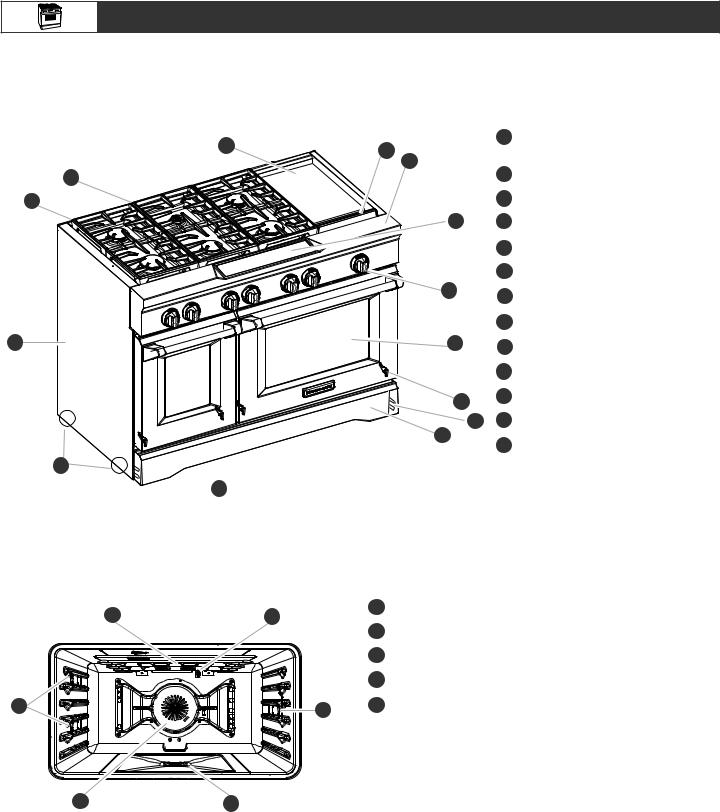
PARTS AND FEATURES
These instructions cover several different models. The range you have purchased may have some or all of the items listed. The locations and appearances of the features shown here may not match those of your model. Refer to these instructions or the Frequently Asked Questions (FAQs) section of our website at www.kitchenaid.com for more detailed instructions.
In Canada, refer to the Customer Service Section at www.kitchenaid.ca.
RANGE
1 |
1 |
13 |
|
|
12 |
|
2 |
2 |
|
3 |
3 |
|
11 |
4 |
|
|
5 |
|
|
6 |
|
10 |
7 |
|
|
|
|
|
8 |
4 |
9 |
9 |
|
|
10 |
|
8 |
11 |
|
|
|
|
6 |
12 |
|
7 |
13 |
|
|
Electric griddle (on some models)
Cooktop grate Island trim Side panels Roller feet Leveling rods
Lower panel/kick plate Oven doors
Window Control knobs Control panel Culinary ledge
Drip tray (on griddle models)
5
 6
6
48" (121.9 cm) range shown
OVEN INTERIOR
2 |
3 |
|
1 |
Halogen lights |
|
|
Broil elements |
||
|
|
|
2 |
|
|
|
|
3 |
Oven cavity sensor |
|
|
|
4 |
Hidden element |
1 |
|
1 |
5 |
Convection fan(s) |
|
|
|
|
5 |
4 |
6
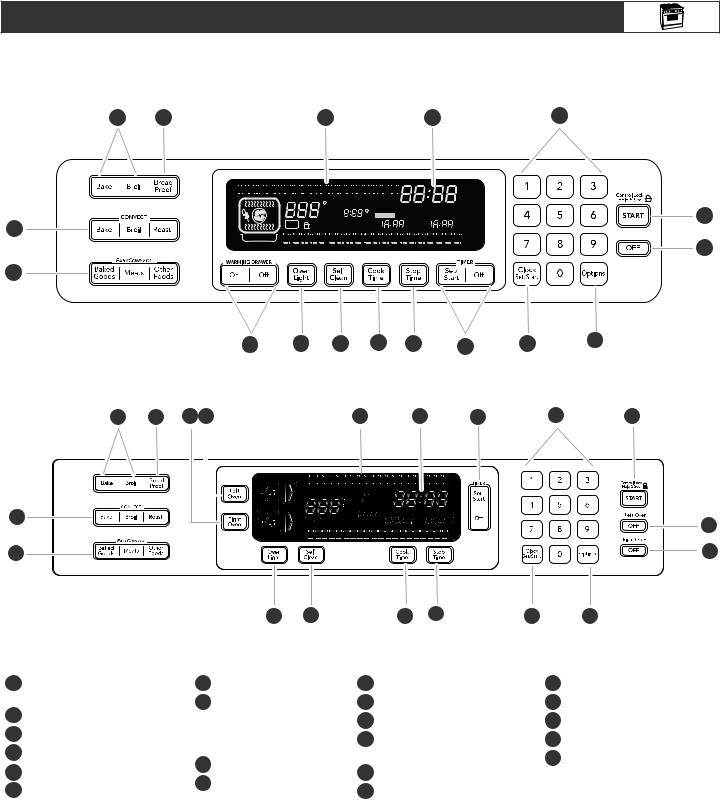
PARTS AND FEATURES
ELECTRONIC OVEN CONTROLS
30" (76.2 CM) AND 36" (91.4 CM)
3 |
4 |
|
5 |
|
|
|
|
|
|
|
|
|
|
|
|
|
|
|
|
6 |
7 |
||||||||||||||||||||||||
|
|
|
|
|
|
|
|
|
|
|
|
|
|
|
|
|
|
|
|
|
|
|
|
|
|
|
|
|
|
|
|
|
|
|
|
|
|
|
|
|
|
|
|
|
|
|
|
|
CLEAN |
TIME |
|
|
|
|
F |
PROBE TEMP |
MIN HR |
SEC MIN |
|
|
|
C |
HR |
MIN |
DELAY |
8 |
|
ON |
START |
||||
2 |
CONTROL |
COOK |
TIME |
STOP |
||
|
LOCKED |
TIME |
TIME |
|||
MED LOW HI
9
1
17 |
16 |
15 |
14 |
13 |
12 |
11 |
10 |
48" (121.9 CM)
3 |
|
|
4 |
18 19 |
|
|
|
|
|
|
|
|
|
|
|
|
|
|
|
5 |
|
|
6 |
|
|
|
|
|
|
|
12 |
7 |
8 |
|||||||||||||||||||||||
|
|
|
|
|
|
|
|
|
|
|
|
|
|
|
|
|
|
|
|
|
|
|
|
|
|
|
|
|
|
|
|
|
|
|
|
|
|
|
|
|
|
|
|
|
|
|
|
|
|
|
|
|
|
|
|
|
|
|
|
|
|
|
|
|
|
|
|
|
|
|
|
|
|
|
|
|
|
|
|
|
|
|
|
|
|
|
|
|
|
|
|
|
|
|
|
|
|
|
|
|
|
|
|
|
|
|
|
|
|
|
|
|
|
|
|
|
|
|
|
|
|
|
|
|
|
|
|
|
|
|
|
|
|
|
|
|
|
|
|
|
|
|
|
|
|
|
|
|
|
|
|
|
|
|
|
|
|
|
|
|
|
|
|
|
|
|
|
|
|
|
|
|
|
|
|
|
|
|
|
|
|
|
|
|
|
|
|
|
|
|
|
|
|
|
|
|
|
|
|
|
|
|
|
|
|
|
|
|
|
|
|
|
|
|
|
|
|
|
|
|
|
|
|
|
|
|
|
|
|
|
|
|
|
|
|
|
|
|
|
|
|
|
|
|
|
|
|
|
|
|
|
|
|
|
|
|
|
|
|
|
|
|
|
|
|
|
|
|
|
|
|
|
|
|
|
|
|
|
|
|
|
|
|
|
2 |
20 |
|
1 |
|
|
|
|
21 |
16 |
15 |
14 |
13 |
11 |
10 |
1 |
EasyConvect™ |
7 |
Number pads |
11 Clock set/start |
17 |
Warming drawer on/off |
|
|
conversion |
8 |
Start (control |
12 Timer |
18 |
Right oven selector |
|
2 |
Convection oven modes |
|
lock/unlock |
13 |
Stop time |
19 |
Left oven selector |
3 |
Oven modes |
|
when pressed |
||||
|
14 Cook time |
20 |
Left oven off |
||||
|
for 5 seconds) |
||||||
|
|
|
|||||
4 |
Bread proof mode |
|
|
(length of cooking time) |
21 |
Right oven off |
|
9 |
Off |
|
|||||
|
Oven display |
|
Self-clean |
||||
5 |
15 |
|
|
||||
10 |
Options selection |
|
|
||||
6 |
Clock/time |
16 |
Oven light (on/off) |
|
|
||
|
pad |
|
|
||||
|
of day display |
|
|
|
|
|
|
|
|
|
|
|
|
|
|
7
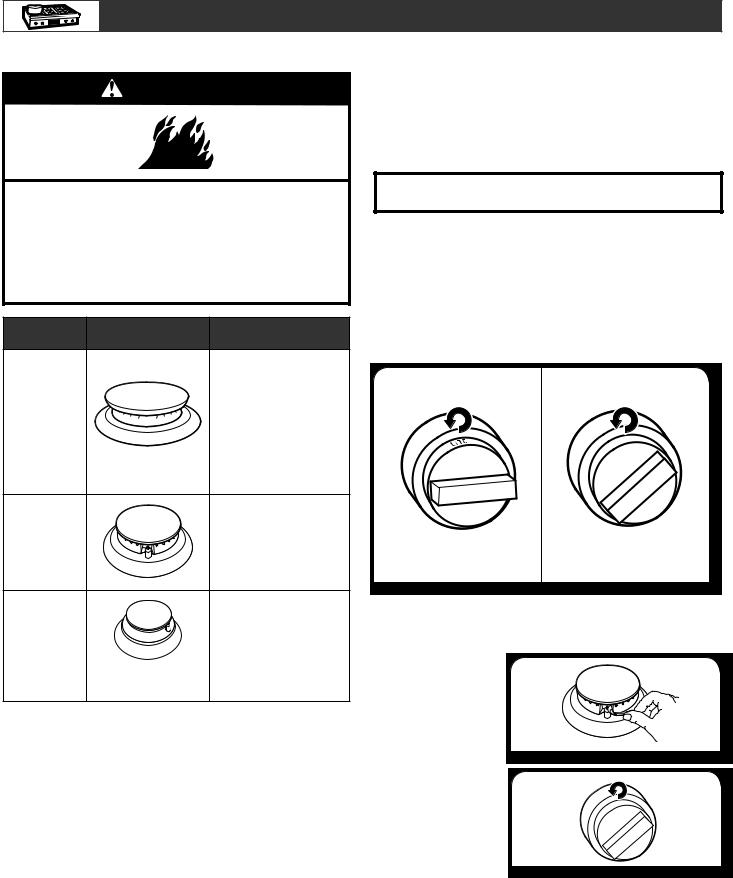
COOKTOP FEATURES
BURNERS
 WARNING
WARNING
Fire Hazard
Do not let the burner flame extend beyond the edge of the pan.
Turn off all controls when not cooking.
Failure to follow these instructions can result in death or fire.
|
BURNER |
|
BTU/Hr |
APPEARANCE |
FEATURES |
Ultra Power™ |
|
This burner has an upper |
dual-flame |
|
and lower level of flame. |
burner |
|
The Power HI setting |
|
|
uses both flame levels at |
|
|
full power to provide the |
|
|
highest heat. It is ideal for |
|
|
cooking large quantities |
|
|
of food or liquid, and |
|
|
using large pots and |
|
|
pans. The Simmer HI |
|
|
and LO settings use the |
|
|
upper flame only. |
Medium |
|
This burner is ideal |
burner |
|
for cooking smaller |
|
|
quantities of food |
|
|
and melting chocolate |
|
|
or butter. |
Simmer |
|
This burner reaches |
burner |
|
a low of 500 BTU/hr. It |
|
|
provides the gentle, low |
|
|
temperatures required |
|
|
for simmering soups, |
|
|
stewing, and melting |
|
|
delicate ingredients |
|
|
like butter, cheese, |
|
|
and chocolate. |
Igniting Burners:
■■ Electric igniters automatically light the surface burners when control knobs are turned to LITE.
■■ Before setting a control knob, place filled cookware on the grate. Do not operate a burner using empty cookware or without any cookware on the grate.
■■ Visually check that the burner has lit. If the burner does not ignite, listen for the clicking sound. If you do not hear the igniter click, turn off the burner. Check for a tripped circuit breaker or blown fuse.
■■ Check that the control knob is pressed completely down on the valve shaft. If the spark igniter still does not operate, call a trained repair specialist.
■■ When the control knobs for any small or medium burner are turned to the LITE position, all small and medium burners will click. When the control knob for the large burner is turned to the LITE position, these burners will click independent of the other burners. In both cases, only the burner with the control knob turned to LITE will produce a flame.
REMEMBER: When range is in use or during the SelfCleaning cycle, the entire cooktop area may become hot.
Reignition Feature
During cooktop use, if one or more burners are extinguished due to external causes (such as a water spill, wind, or ventilation draft), the ignition system will turn on to reignite the flame. When the flame comes back on, the system will stop sparking. If the draft in the room is not removed, occasional sparking may continue. Sparking may also occasionally occur when using the low setting on a burner.
To Set a Burner:
1. 2.
|
|
|
|
|
|
|
|
|
|
Push in and turn |
Turn knob counterclockwise |
|||
counterclockwise to LITE. |
between HI and LO. |
|||
Push in one more time to get from LO to HI.
In Case of Power Failure
Hold a lit match near a burner, and turn knob counterclockwise to HI. After burner lights, turn knob to the desired setting.
8
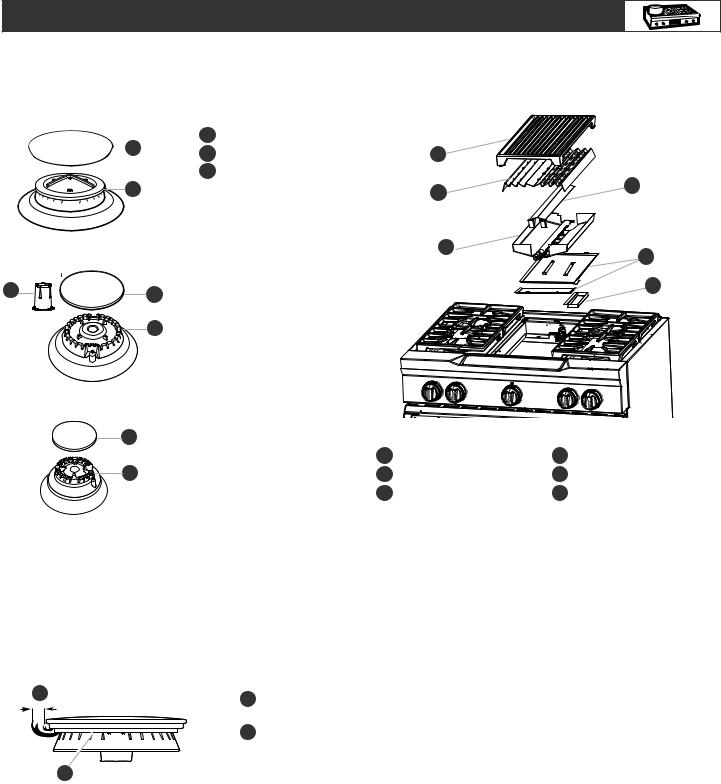
COOKTOP FEATURES
Sealed Surface Burners
Sealed surface burners are designed to minimize gaps and seams that can allow liquids and spills to get under the cooktop. This design makes cleanup quick and easy.
Stacked Power Burner
 1
1
2
Medium Burner
3 |
1 |
|
2
Simmer/Melt Burner
1
1Burner cap
2Burner base
3Choke (for use with medium burner, propane only)
2
IMPORTANT: Do not obstruct the flow of combustion and ventilation air around the burner grate edges.
Burner cap: Always keep the burner cap in place when using a surface burner. A clean burner cap will help avoid poor ignition and uneven flames. Always clean the burner cap after a spillover, and routinely remove and clean the caps according to the “Care and Cleaning” section.
Gas opening: Gas must flow freely throughout the gas opening for the burner to light properly. Keep this area free of soil, and do not allow spills, food, cleaning agents, or any other material to enter the gas opening. Keep spillovers out of the gas opening by always using a burner cap.
1 1 1-1¹⁄2"
(2.5-3.8 cm)
2 Burner ports
2
Burner ports: Check burner flames occasionally for proper size and shape as shown above. A good flame is blue in color, not yellow. Keep this area free of soil, and do not allow spills, food, cleaning agents, or any other material to enter the burner ports.
GRILL (ON SOME MODELS)
The grill module consists of a cast-iron grate, a wave tray, a flame spreader, a burner assembly, 2 grease trays and a drip tray.
1
2 |
|
4 |
|
|
|
|
3 |
5 |
|
|
6
1 |
Grill grate |
4 |
Flame spreader |
2 |
Wave tray |
5 |
Grease trays |
3 |
Burner assembly |
6 |
Drip tray |
When using the grill, follow the guidelines below:
■■ Trim excess fat to reduce spattering. Slit the remaining fat on the edges to avoid curling.
■■ Allow space between food on the grill. Crowding food will result in uneven cooking.
■■ Use a metal spatula or tongs to turn food.
■■ Steaks, chops and hamburgers should be turned only once to avoid loss of juices.
■■ For even cooking, foods such as chicken quarters should be turned several times.
■■ To check for doneness of meats and poultry, use an instant read thermometer or make a small cut in the center of the food. This will avoid loss of juices.
■■ Do not leave the grill unattended while cooking.
■■ To avoid damage to the grill, do not use aluminum foil, charcoal or wood chips.
■■ To avoid damage to cookware, do not place cookware on the grill when in use. Food should be cooked directly on the grill grate.
9
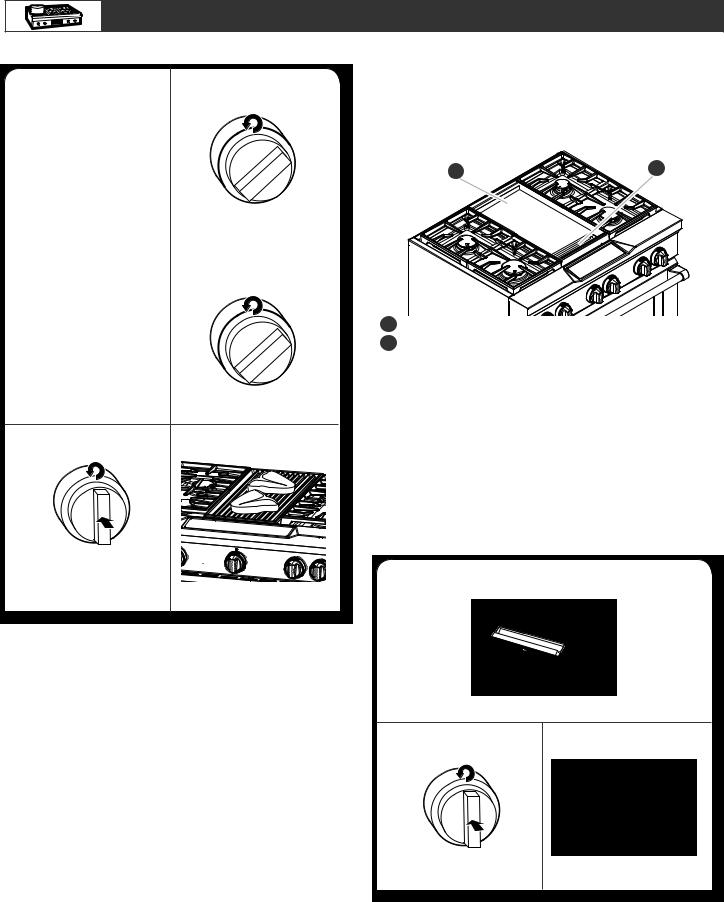
COOKTOP FEATURES
To Use:
1. 4.
Turn on overhead range hood.
|
Turn knob to MED and |
|
allow grill to preheat for |
|
15 minutes. |
|
|
2. |
5. |
Apply vegetable oil, if |
|
desired. Apply a light coating |
|
of vegetable oil or nonstick |
|
cooking spray to grill grate. |
|
Turn knob to desired cook setting.
3. 6.
Push in and turn knob to LITE/HI. The flame will ignite
in 1-4 seconds.
Place food on grill.
CHROME ELECTRIC GRIDDLE (ON SOME MODELS)
The chrome electric griddle provides the perfect cooking surface for grilled sandwiches, pancakes, eggs, burgers, sautéed vegetables, and many more family favorites. The attractive low-stick surface is designed to make cleanup easy.
1 |
2 |
1Griddle
2Drip tray
The chrome electric griddle system provides an evenly heated cooking surface.
■■ Be sure plastic film has been removed, and wash with hot water before first use.
■■ To avoid scratching the griddle, do not place any pots or pans on the griddle. Use only heat resistant plastic or wooden utensils.
■■ The griddle surface is ready to use and does not need to be seasoned.
■■ Pouring cold water on a hot griddle may warp the griddle, resulting in an uneven cooking surface.
To Use:
1.
Position drip tray.
2. 3.
Push in and turn knob. |
Place food on griddle, and |
|
cook to desired doneness. |
The griddle light will turn off when the griddle has finished preheating. The griddle light will turn on and off during use to indicate that the griddle element is maintaining the selected surface temperature.
10
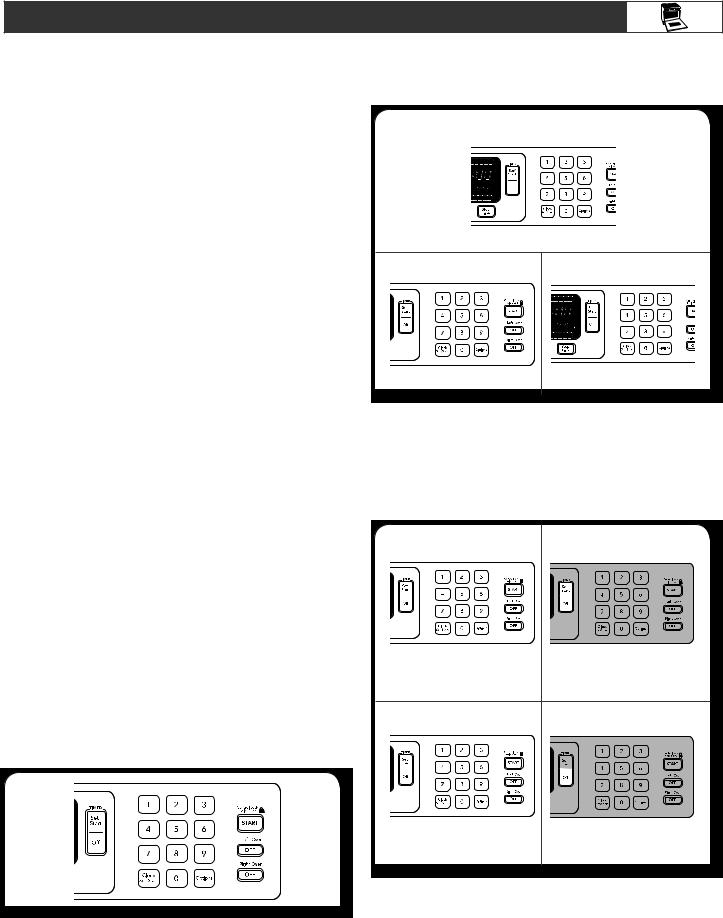
USING YOUR OVEN
CONTROL PANEL
When pressing any control pad function on the Electronic Oven Control, use the pad of your finger to press the desired function. Hold down the pad a few seconds, or until the desired function appears in the display.
When entering multiple functions within one setting, pause briefly between each control pad command. If a command pad is pressed several times repeatedly, the pad may briefly stop working. Wait a few seconds, and the pad should function again as normal.
OVEN DISPLAY
■■ When the oven is in use, this display shows the oven temperature, heat source(s) and start time.
■■ During Timed Cooking, this display also shows a timed countdown and the stop time (if entered).
■■ If “Err” appears on the display, an invalid pad was pressed. Press OFF and retry your entry.
■■ When the oven is not in use this display is blank, except for the clock display.
FUNCTIONS
Control Panel
Using the Start Pad
The START pad begins any oven function except the Timer, Control Lock and Sabbath Mode. If not pressed within 5 seconds after pressing a pad, “START?” will appear on the oven display as a reminder. If not pressed within 5 minutes after pressing a pad, the oven display will return to inactive mode (blank) and the programmed function will be canceled.
If a function has been started and a different function is selected, “START?” will appear in the display after 5 seconds. If the START pad is not pressed within 5 seconds, the oven display will return to the active/already started function.
Using the Off Pad
The OFF pad stops any oven function except for the Clock, Timer, and Control Lock.
Using Control Lock
The Control Lock shuts down the control panel pads to avoid unintended use of the oven(s).
The Control Lock feature may be used either when the range is in use or turned off (for example, during cleaning).
The Control Lock is preset unlocked, but can be locked.
When the control is locked, only the TIMER SET/START, TIMER OFF and OVEN LIGHT pads will function.
To Lock or Unlock Control:
Before locking, make sure the oven, the Timer and Timed Cooking are off.
Press and hold START for 5 seconds until “CONTROL LOCKED” appears on the display. Repeat to unlock and remove “CONTROL LOCKED” from the display.
Clock
Setting the Clock
This is a 12-hour clock.
1.
Press CLOCK SET/START.
2. |
3. |
Enter time of day. |
Press CLOCK SET/START. |
TIMER
Setting the Timer
The Timer can be set in minutes and seconds or hours and minutes and counts down the set time. The time can be reset during the countdown by repeating the steps below.
NOTE: The Timer does not start or stop the oven.
1. 3.
|
|
|
|
|
|
|
|
|
|
|
|
|
|
|
|
Press TIMER SET/START. |
Press TIMER SET/START. |
||||||
Press again to switch from |
When time reaches 0:00, |
||||||
MIN/SEC and HR/MIN. |
4 chimes will sound until |
||||||
|
|
|
|
TIMER OFF is pressed. |
|||
2. 4.
|
|
|
|
|
|
|
|
|
|
|
|
|
|
|
|
|
|
Enter desired time. |
|
|
|
|
|
|||
Press TIMER OFF at any |
||||||||
|
|
|
|
time to cancel Timer or stop |
||||
|
|
|
|
reminder tones. |
||||
11
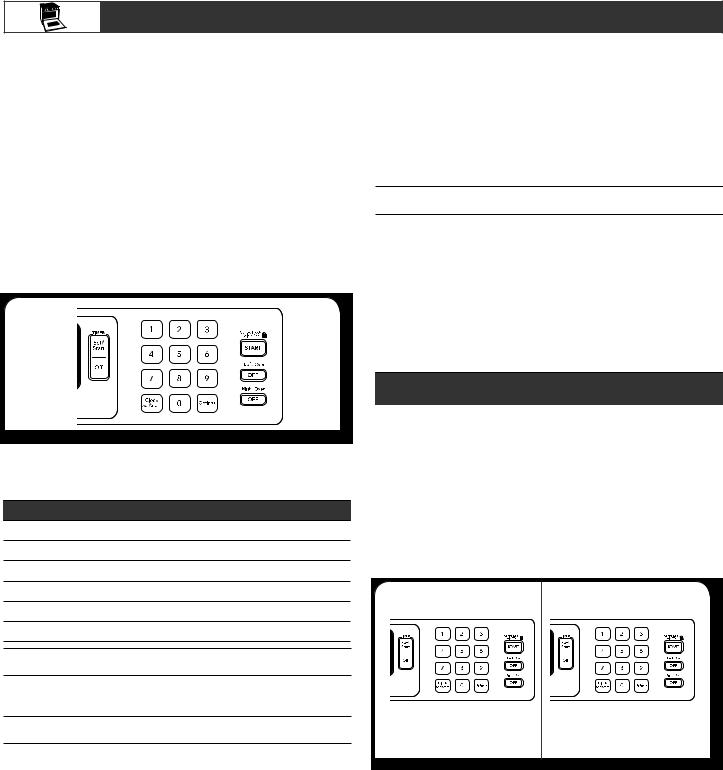
USING YOUR OVEN
OPTIONS
These instructions cover different models. The oven you have purchased may have some or all of the items listed. The locations and appearances of the items shown here may not match those of your model.
Options Selection Pad
The OPTIONS selection pad allows you to access special functions within the Electronic Oven Control that allow you to customize the product to your needs. These special functions allow you to change the oven temperature between Fahrenheit and Celsius, turn the audible signals and prompts on and off, and adjust the oven calibration. The Dehydrate and Sabbath Mode are also set using the OPTIONS selection pad.
NOTE: The Sabbath mode can only be set using the Options selection pad after the mode is enabled (See “Sabbath Mode – Option 7” section.)
To Use:
Press OPTIONS. The oven display will scroll through the 6 options, or you can press a number pad to quickly enter the desired hidden function. Each time an option is selected, the oven will toggle to the setting displayed.
OPTIONS |
SPECIAL FUNCTION |
1Fahrenheit and Celsius conversion
2Tones On/Off
3Tones High/Low
4Cooking Time Completion Tones On/Off
6Oven Temperature Calibration
7Sabbath Mode
Fahrenheit and Celsius – Option 1
Fahrenheit is the default setting, but setting may be changed to Celsius.
Tones – Options 2, 3, 4
Tones are audible signals, indicating the following:
One beep
■■ Function has been entered
Three beeps
■■ Invalid pad press
Preheat Completion Tone
■■ One chime indicates a preheat cycle has been completed.
Timer Completion Tones
■■ Four chimes sound twice when the timer reaches zero. This can occur when using the timer for functions other than cooking.
Cooking Time Completion Tones
■■ Three beeps indicate the end of a cooking cycle.
All Tones ON/OFF
All tones are preset to ON, but can be turned OFF.
Tone Volume High/Low
The volume is preset to HIGH but can be changed to LOW.
Cooking Time Completion Tones ON/OFF
All tones are preset to ON but can be turned OFF.
Oven Temperature Calibration – Option 6
IMPORTANT: Do not use a thermometer to measure oven temperature because opening the oven door during cycling may give incorrect readings.
The oven provides accurate temperatures; however, it may cook faster or slower than your previous oven, so the temperature calibration can be adjusted. It can be changed in Fahrenheit or Celsius.
A minus sign means the oven will be cooler by the displayed amount. The absence of a minus sign means the oven will be warmer by the displayed amount. Use the following chart as a guide.
ADJUSTMENT °F |
|
(AUTOMATIC °C CHANGE) |
COOKS FOOD |
30°F (15°C) |
...much more |
|
|
20°F (10°C) |
...moderately more |
|
|
10°F (5°C) |
...a little more |
|
|
0°F (0°C) |
...default setting |
|
|
-10°F (-5°C) |
...a little less |
|
|
-20°F (-10°C) |
...moderately less |
|
|
-30°F (-15°C) |
...much less |
|
|
To Adjust: |
|
1. 2.
|
|
|
|
|
|
|
|
|
|
|
|
|
|
|
|
Press 3 to increase or 6 to |
Press START to end |
||||||
decrease the temperature |
calibration. |
||||||
calibration level by |
|
|
|
|
|||
10 degrees. |
|
|
|
|
|||
12
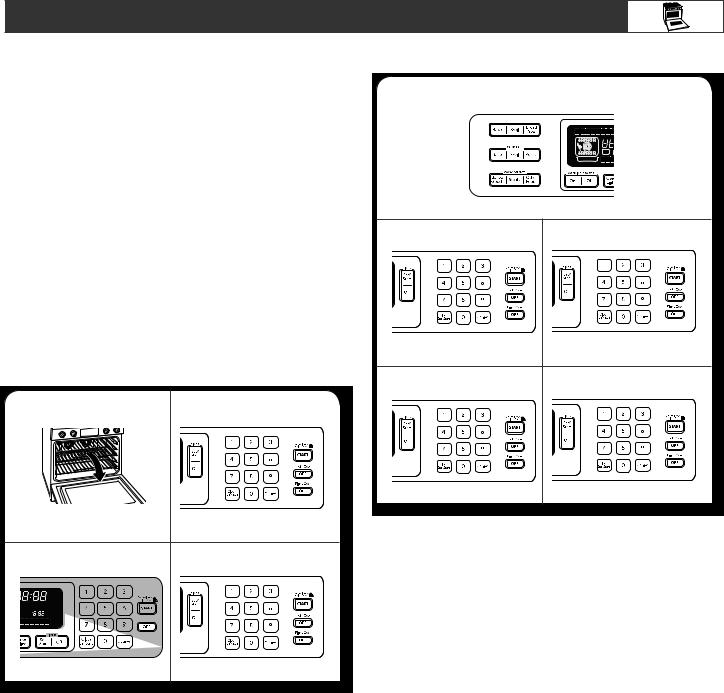
USING YOUR OVEN
Sabbath Mode
■■ The Sabbath Mode sets the oven(s) to remain ON in a bake setting until turned off.
■■ A timed Sabbath Mode can also be set to keep the oven on for only part of the Sabbath.
■■ When the Sabbath Mode is set, only the number and start keys will function.
■■ No tones will sound, and the display will not show messages or temperatures changes.
■■ The heat source icons will appear lit on the oven display throughout the Sabbath Mode.
■■ When the oven door is opened or closed, the oven light will not turn on or off and the heating elements will not turn on or off immediately.
■■ If a power failure occurs when the Sabbath Mode is set, the oven will remain in Sabbath Mode but will no longer be actively cooking. The “ON” indicator will no longer be illuminated. Press OFF to return to normal operating mode (non-Sabbath Mode compliant, not cooking).
To Enable:
IMPORTANT: Before the Sabbath Mode can be regularly set, the oven(s) must first be enabled with a one time only setup.
1. |
|
3. |
Open oven door. |
Press number pads 7,8,9,6 |
|
|
|
in this order. |
2. |
|
4. |
N HR |
SEC MIN |
|
TART |
STOP |
|
IME |
TIME |
|
Press OFF. |
Press START. |
|
To Disable:
The Sabbath Mode setting capability can be disabled by repeating the previous steps. The Sabbath Mode cannot be regularly set until re-enabled.
To Set Regularly Untimed:
1.
ON
MED LOW HI
Press BAKE.
2. 4.
Change preset temperature, Press OPTIONS. if desired.
3. 5.
|
|
|
|
|
|
|
|
|
|
|
|
|
|
|
|
|
|
|
|
Press number pad 7. |
|||
Press START. |
|||||||
13
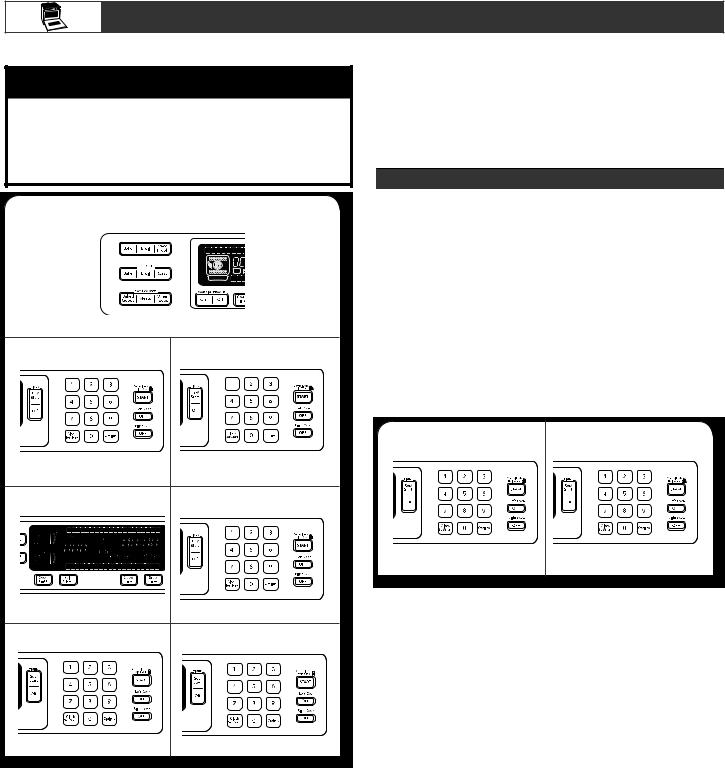
USING YOUR OVEN
To Set Regularly Timed:
 WARNING
WARNING
Food Poisoning Hazard
Do not let food sit in oven more than one hour before or after cooking.
Doing so can result in food poisoning or sickness.
1.
ON
MED LOW HI
Press BAKE.
2. |
5. |
Change preset temperature, |
Press START. |
if desired. |
|
3. |
6. |
Press COOK TIME. |
Press OPTIONS. |
4. |
7. |
Enter cook time. |
Press number pad 7. |
When the stop time is reached, the oven will automatically turn off. The oven control will remain in the Sabbath Mode until the OFF button is pressed.
Temperature Change
The oven temperature can be changed when the oven(s) are in the Sabbath Mode. No tones will sound, and the display will not change. The heating elements will not turn on or off for a random time, anywhere from 16 to 24 seconds. It may take up to 30 minutes for the oven to change temperature.
Number pads 1 through 0 represent temperatures. Use the following chart as a guide.
|
|
|
NUMBER KEY |
|
|
|
OVEN TEMPERATURE |
|
|
|
|
|
|
|
|
|
|
1 |
|
|
|
|
170°F (77°C) |
|||
|
|
|
|
|
|
|
|
|
2 |
|
|
|
|
200°F (95°C) |
|||
|
|
|
|
|
|
|
|
|
3 |
|
|
|
|
225°F (107°C) |
|||
|
|
|
|
|
|
|
|
|
4 |
|
|
|
|
250°F (120°C) |
|||
|
|
|
|
|
|
|
|
|
5 |
|
|
|
|
300°F (149°C) |
|||
|
|
|
|
|
|
|
|
|
6 |
|
|
|
|
325°F (163°C) |
|||
|
|
|
|
|
|
|
|
|
7 |
|
|
|
|
350°F (177°C) |
|||
|
|
|
|
|
|
|
|
|
8 |
|
|
|
|
375°F (191°C) |
|||
|
|
|
|
|
|
|
|
|
9 |
|
|
|
|
400°F (204°C) |
|||
|
|
|
|
|
|
|
|
|
0 |
|
|
|
|
450°F (232°C) |
|||
|
|
|
|
|
|
|
|
|
To Change Temperature: |
|
|
|
|
|
|||
1. |
|
2. |
|
|
||||
|
|
|
|
|
|
|
|
|
|
|
|
|
|
|
|
|
|
Press the number pad from Press START. the chart.
14

USING YOUR OVEN
KNOW YOUR OVEN
■■ Odors and smoke are normal when the oven is used the first few times, or when it is heavily soiled.
■■ IMPORTANT: The health of some birds is extremely sensitive to the fumes given off. Exposure to the fumes may result in death to certain birds. Always move birds to another closed and well-ventilated room.
■■ IMPORTANT: This oven automatically adjusts for 208V operation without affecting cooking performance. Preheat times may be longer.
Aluminum Foil
■■ IMPORTANT: To avoid permanent damage to the oven bottom finish, do not line the oven bottom with any type of foil or liner.
■■ On models with bottom oven vents, do not block or cover the vents.
■■ For best cooking results, do not cover rack with foil because air must be able to move freely.
Positioning Rack and Bakeware
IMPORTANT: To avoid permanent damage to the porcelain finish, do not place food or bakeware directly on the oven door or bottom.
Racks |
5 |
|
■■ Position racks before turning on the |
||
4 |
||
oven. |
||
■■ Do not position racks with bakeware |
3 |
|
2 |
||
on them. |
||
■■ Make sure racks are level. |
1 |
|
|
To move a rack, pull it out to the stop position, raise the front edge, then lift out. Use the following illustration and charts as a guide.
Bakeware
To cook food evenly, hot air |
|
|
must be able to circulate. Allow 2" |
|
|
(5.0 cm) of space around bakeware |
2" |
2" |
and oven walls. For convection |
(5 cm) |
(5 cm) |
cooking, allow 1" (2.5 cm) of space |
|
|
around bakeware and oven walls. |
|
|
Roll-Out Extension Rack
The roll-out extension rack allows easy access to position and remove food in the oven. It can be used in rack positions 1 through 4. The roll-out extension rack will not fit in position 5.
Open Position |
|
1 |
2 |
Closed and Engaged Position
1 
2
1Roll-out extension rack
2Sliding shelves
To Remove the Roll-Out Extension Rack:
1.
Lift up rack/shelf front and slide in.
Rack must be closed and engaged with sliding shelf. Using 2 hands, lift up on front edge of rack and sliding shelf together. Slowly push both to back wall of oven.
The front edge of the sliding shelf should sit on the rack guide located on the sides of the oven.
The front edge of the rack and the sliding shelf should be higher than the back edge.
1
2
3
1Sliding shelf
2Rack guide
3Roll-out extension rack
15
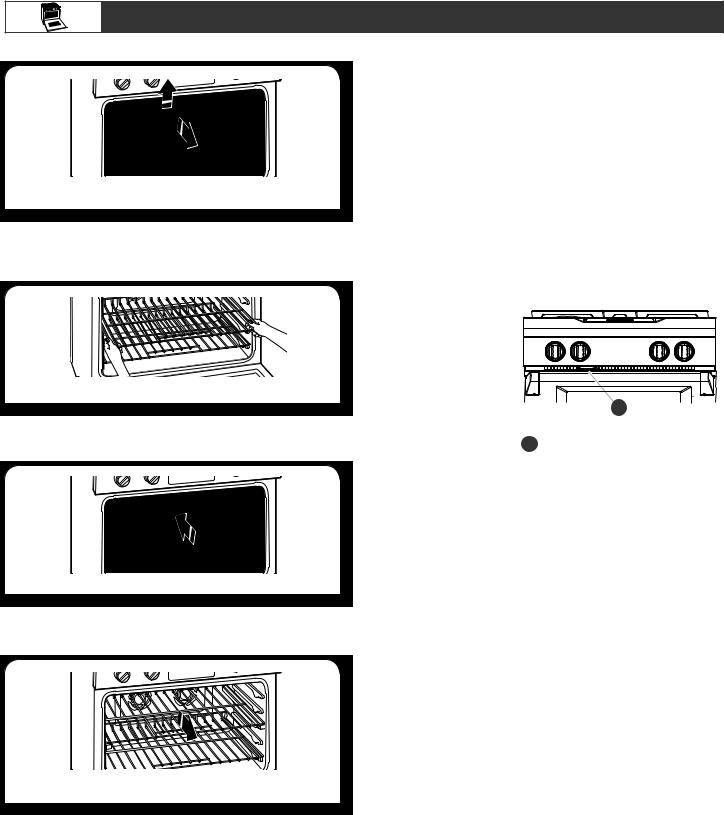
USING YOUR OVEN
2.
Lift up rack/shelf rear.
Using 2 hands, lift up back of rack and sliding shelf so that back and front are level on rack guide. Pull out.
To Replace the Roll-Out Extension Rack:
1.
Place on rack guide.
Using 2 hands, grasp front of the closed rack and sliding shelf. Place the closed rack and sliding shelf on the rack guide.
2.
Slide in rack/shelf.
Slowly push the rack and sliding shelf to the back of oven until the back edge of the sliding shelf drops.
3.
Pull rack/shelf forward.
Pull the rack and sliding shelf slightly forward until the front edge drops and the sliding shelf is on the rack guide.
Know Your Racks
■■ To avoid damage to the sliding shelves, do not place more than 25 lbs (11.4 kg) on the rack.
■■ Do not clean the roll-out extension rack in a dishwasher. It may remove the rack’s lubricant and affect its ability to slide.
■■ See the “Care and Cleaning” section for more information.
Meat Thermometer
When not using the supplied temperature probe, use a meat thermometer to determine whether meat, poultry, and fish are cooked to the desired degree of doneness. The internal temperature, not appearance, should be used to determine doneness. A meat thermometer is not supplied with this appliance. Follow manufacturer’s directions for using a meat thermometer.
Oven Vent
The oven vent should not be blocked or covered since it allows the release of hot air and moisture from the oven. Blocking or covering the vent will cause poor air circulation, affecting cooking and cleaning results. Do not
put plastics, paper, or 1 other items that could
melt near the oven vent.
1 Oven vent
16
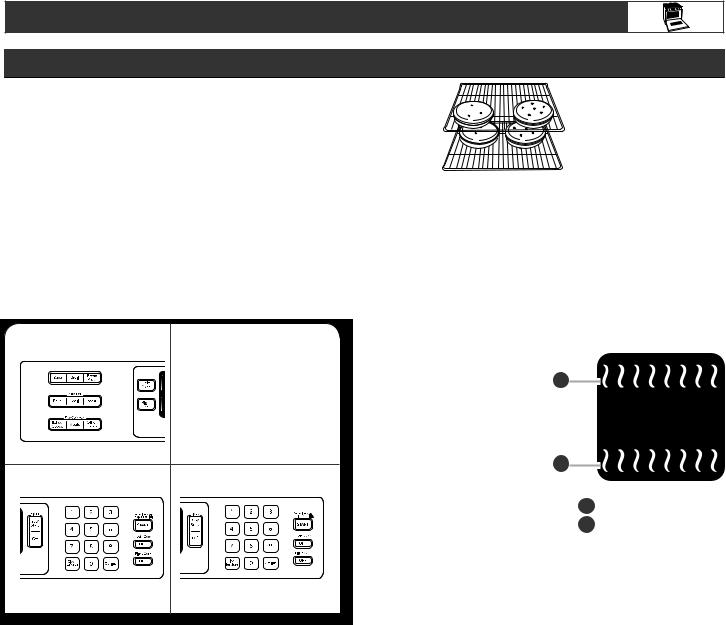
USING YOUR OVEN
|
RECOMMENDED |
RECOMMENDED RACK |
|
BAKED GOODS |
MODE(S) |
POSITION(S) |
TIPS |
Cakes |
Bake, Convect Bake |
Three racks — 1, 3, 5 |
|
|
Two racks — 2 and 4 |
|
|
One rack — 3 |
For best results when baking cakes on two racks, place the cakes on the racks as shown.
Cookies |
Bake, Convect Bake |
Three racks — 1, 3, 5 |
|
|
Two racks — 1 and 4, 2 and 4 |
|
|
(Convect Bake only) |
|
|
One rack — 3 |
TRADITIONAL COOKING |
Baking and Roasting |
|
|
||
|
|
The Bake/Roast Mode relies primarily on heat from the lower |
|||
Bake, Roast, and Broil |
|
bake element and radiant heat from the oven cavity to produce |
|||
Set traditional cooking modes by following these steps: |
the perfect conditions for cakes, cookies, quick breads, yeast |
||||
breads, meatloaf, and baked desserts. This mode is perfect for |
|||||
|
|
||||
|
|
foods that require both upper and lower browning. |
|||
1. |
3. |
Know Your Bake/Roast Mode |
|
|
|
■■ During baking or roasting, |
|
|
|||
|
Set optional modes (Bake |
the bake and broil elements |
|
|
|
|
and Roast only). |
will cycle on and off in |
1 |
|
|
|
(See “Time/Delay Cooking” |
intervals to maintain the |
|
|
|
|
oven temperature. |
|
|
||
|
section.) |
|
|
||
|
|
|
|
||
|
(See “Temperature Probe” |
■■ If the oven door is opened |
|
|
|
|
section.) |
during baking or roasting, |
|
|
|
Touch desired mode. |
|
the heating elements |
|
|
|
|
(bake, both broils, and |
2 |
|
||
|
|
|
|||
2. |
4. |
convection fan) will turn off |
|
||
|
|
||||
approximately 30 seconds |
|
|
|||
|
|
after the door is opened. |
1 |
Broil elements |
|
|
|
They will turn on again |
|||
|
|
approximately 30 seconds |
2 |
Bake element |
|
|
|
after the door is closed. |
|
|
|
|
|
■■ For baking, allow the range |
|
|
|
|
|
to preheat before placing |
|
|
|
Enter desired cooking |
Touch START. |
food in the oven. |
|
|
|
■■ When roasting, it is not necessary to wait for the oven to |
|||||
temperature. |
|
||||
|
preheat before putting food in, unless recommended in |
||||
|
|
||||
|
|
the recipe. |
|
|
|
17

USING YOUR OVEN
True-Broil® Reflector Full and Center Broiling
The Broil Mode uses intense heat from above to cook foods quickly and is ideal when you want rich, flavorful browning of exterior surfaces. Use for steak, chicken, pork, fish, or
vegetables like onions and peppers. This mode can also brown and crisp desserts or casserole toppings.
Know your Broil Mode
■■ Broiling uses direct radiant heat to cook food.
■■ During full broiling, both the inner and outer broil elements heat. During center broiling, only the inner broil element heats. The element(s) cycle on and off in intervals to maintain the oven temperature.
■■ Press BROIL once for full broil or twice for center broil (right oven only).
■■ If the oven door is opened during broiling, the broil element will turn off in approximately 30 seconds. When the oven door is closed, the elements will come back on approximately 30 seconds later.
■■ For best results, use a broiler pan and grid. It is designed to drain juices and help avoid spatter and smoke.
1 







2 





1Full Broil
2Center broil
■■ For proper draining, do not cover the grid with foil. The bottom of the broiler pan may be lined with aluminum foil for easier cleaning.
■■ Trim excess fat to reduce spattering. Slit the remaining fat on the edges to avoid curling.
■■ When broiling, changing the temperature allows more precise control. The lower the temperature, the slower the cooking. Thicker cuts and unevenly shaped pieces of meat, fish, and poultry may cook better at lower broiling temperatures.
■■ Pull out oven rack to stop position before turning or removing food. Use tongs to turn food to avoid the loss of juices. Very thin cuts of fish, poultry, or meat may not need to be turned.
■■ After broiling, remove the pan of food from the oven. Drippings will bake on the pan if left in the heated oven, making cleaning more difficult.
Even-Heat™ True Convection Cooking
Convection Bake, Convection Roast, Convection Broil, and EasyConvect™ Conversion
Even-Heat™ true convection cooking uses a fan in the oven to circulate hot air continually. This distributes heat more evenly than the natural movement of air in a standard thermal oven. The movement of hot air helps maintain a consistent temperature throughout the oven, cooking foods more evenly, crisping surfaces while sealing in moisture and yielding crustier breads.
It is normal for the convection fan to cycle on and off during a cooking cycle.
Baked goods and casseroles can be cooked by lowering cooking temperatures 25°F (14°C). It is not necessary to reduce temperature when cooking meats and poultry. Cooking times for large turkeys and other poultry may be shorter when using the convection function.
■■ It is important not to cover foods with lids or aluminum foil so that surface areas remain exposed to the circulating air, allowing browning and crisping.
■■ Keep heat loss to a minimum by opening the oven door only when necessary.
■■ Choose cookie sheets without sides and roasting pans with lower sides to allow air to move freely around the food.
■■ Test baked goods for doneness a few minutes before the minimum cooking time using a method such as a toothpick.
■■ Use a meat thermometer or the temperature probe to determine the doneness of meats and poultry. Check the temperature of pork and poultry in 2 or 3 places.
Set convection cooking modes by following these steps:
1. 3.
Set optional modes (Convection Bake and Roast
only).
(See “Time/Delay Cooking”
section.)
(See “Temperature Probe” Press CONVECT BAKE, section.)
ROAST, or BROIL.
2. 4.
|
|
|
|
|
|
|
|
|
|
|
|
|
|
|
|
Enter desired cooking |
|
|
|
|
|||
Press START. |
|||||||
temperature. |
|
|
|
|
|||
18
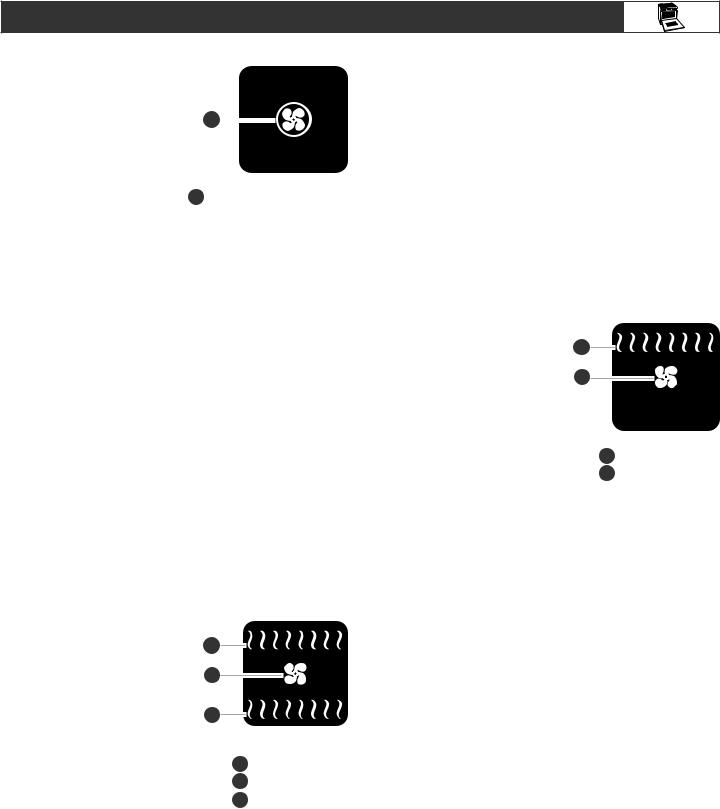
USING YOUR OVEN
Convection Baking
The Convection Bake mode uses |
|
|
|
an element and a fan to circulate |
|
|
|
hot air throughout the oven, |
|
|
|
resulting in baking 10–20% faster |
1 |
|
|
than traditional baking. Convection |
|
|
|
|
|
||
baking can be used for most |
|
|
|
baked goods, but it is exceptional |
|
|
|
for baking cookies, biscuits, pies, |
|
|
|
pasta dishes, casseroles, and |
|
|
|
frozen or convenience foods. |
1 Convection element |
||
Know Your Convection Bake |
|||
Mode |
(hidden) and fan |
||
■■ A convection element is hidden in the rear panel of the oven cavity, and assisted by the convection fan, provides balanced, efficient heating.
■■ Convection baking can be used for baking delicate cakes and pastries, as well as foods on multiple racks. It is helpful to stagger items on the racks to allow a more even flow of heat. If the oven is full, extra cooking time may be needed.
■■ When cooking an oven meal with several different types of foods, be sure to select recipes that require similar
temperatures. Cookware should sit in the oven with at least 1" (2.5 cm) of space between the cookware and the sides of the oven.
■■ During convection baking preheat, the convection element, broil element, and the CleanBake™ element all heat the oven cavity. After preheat, the convection element, the CleanBake™ element, and the fan will cycle on and off in intervals to maintain oven temperature.
■■ If the oven door is opened during convection baking, the fan turns off immediately when the door is opened and turns on immediately when the door is closed. Convection, Bake and Broil (only during preheating) elements will turn off approximately 30 seconds after the door is opened. They will turn on again approximately 30 seconds after the door is closed.
■■ Reduce recipe temperature 25°F (14°C). The cook time may need to be reduced also.
Convection Roasting
The Convect Roast Mode uses multiple elements and a fan to stream heated air throughout the cavity.
The circulating air caramelizes food surfaces for enhanced flavor while maintaining moist and tender interiors. Convect Roast is perfect for roasting meats, poultry, firmfleshed fish, and vegetables. The
consistent and even heat distribution speeds cooking up to 25% compared to traditional roasting. The recipe temperature does not need to be reduced for this mode.
1
2
3
1Broil heat
2Convection fan
3Bake heat
Know Your Convection Roast Mode
■■ If the oven door is opened during convection roasting, the fan turns off immediately when the door is opened and turns on immediately when the door is closed. Broil and bake elements will turn off approximately 30 seconds after the door is opened. They will turn on again approximately 30 seconds after the door is closed.
■■ It is not necessary to reduce oven temperature when roasting with convection. Roasting time may be shorter for poultry.
■■ For best results, use a broiler pan, grid, and roasting rack designed to drain juices and help avoid spatter and smoke.
Before Using Convection Roast:
■■ It is not necessary to wait for the oven to preheat before putting in food, unless recommended in the recipe.
■■ Use a roasting rack on top of the broiler pan and grid. This holds the food above the grid and allows air to circulate completely around all surfaces.
Convection Broiling
The Convect Broil Mode uses multiple elements and a fan to stream heated air throughout the cavity.
Convection broil shortens broiling times by removing the insulating air from around the food, allowing the moving hot air to cook the food faster. Thick, tender cuts of meat, fish, and poultry benefit from this cooking method.
Know Your Convection Broil Mode
1
2
1Broil heat
2Convection fan
■■ During convection broiling, the broil elements will cycle on and off in intervals to maintain oven temperature, while the fan constantly circulates the hot air.
■■ The temperature is preset at 325°F (163°C), but can be changed to a different temperature. Cooking times will vary depending on the rack position and temperature and may need to be adjusted.
■■ If the oven door is opened during convection broiling, the fan turns off immediately when door is opened and turns on again immediately when door is closed. Broil elements will turn off approximately 30 seconds after the door is opened. They will turn on again approximately 30 seconds after the door is closed.
Using Convection Broil:
■■ Before convection broiling, see “True-Broil® Reflector Full and Center Broiling” section for general broiling guidelines.
■■ Position food on the unheated grid on the broiler pan, then place it in the center of the oven rack with the longest side parallel to the door.
19
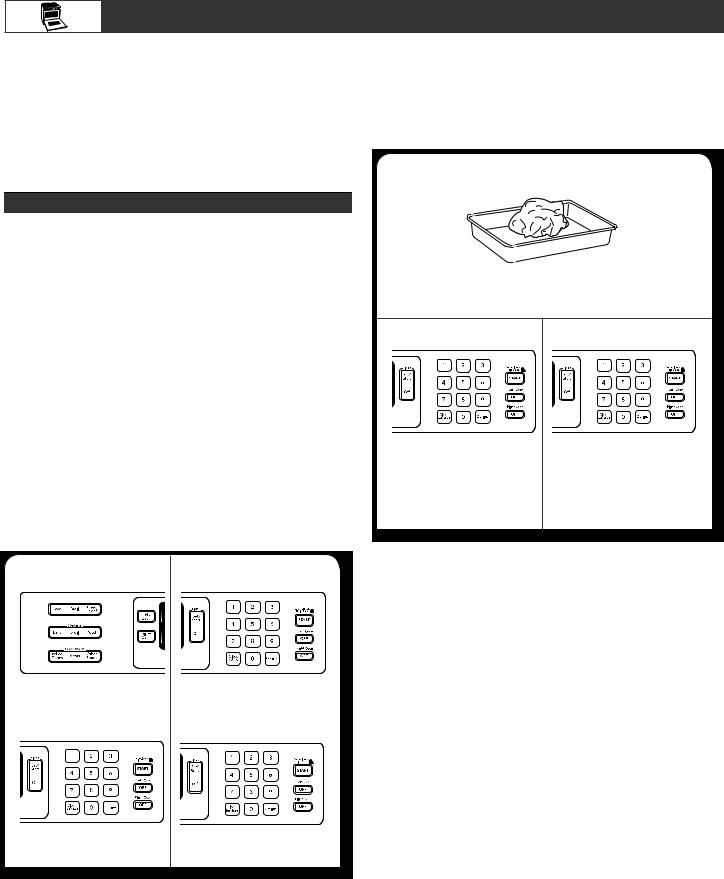
USING YOUR OVEN
EasyConvect™ Conversion
Convection temperatures and times can differ from those of standard cooking. Depending upon the selected category, EasyConvect™ conversion will automatically reduce standard recipe temperatures and/or times for convection cooking.
Foods are grouped into 3 general categories. Choose the category most appropriate for the food to be cooked. To ensure optimal cooking results, the oven will prompt a food check at the end of a non-delayed cook time.
Use the following chart as a guide:
SETTING |
COOKS FOOD |
|
|
Baked Goods |
Biscuits, Breads: quick and yeast |
|
Cakes and Cookies |
|
Casseroles: including frozen |
|
entrées and soufflés |
|
Fish |
|
|
Meats |
Baked potatoes, Chicken: whole |
|
and pieces |
|
Meat Loaf, Roasts: pork, beef, |
|
and ham |
|
(Turkey and large poultry are not |
|
included because their cook times |
|
vary.) |
Other Foods |
Convenience foods: french fries, |
|
nuggets, fish sticks, pizza |
|
Pies: fruit and custard |
|
|
Biscuits & Bread |
Biscuits, Breads: quick and yeast |
|
|
To Use EasyConvect™ Conversion:
When using convection temperature conversion for BAKED GOODS and OTHER FOODS, allow the oven to preheat before placing food in the oven. When using convection for meats, preheating is not necessary.
1. 3.
|
|
|
|
|
|
|
|
|
|
|
|
|
|
|
|
|
|
|
|
|
|
|
|
|
|
|
|
|
|
|
|
|
|
|
|
|
|
|
|
|
|
|
|
|
|
|
|
|
|
|
|
|
|
|
|
|
|
|
|
|
|
|
|
|
|
|
|
|
|
|
|
|
|
|
|
|
|
|
|
|
|
|
|
|
|
|
|
|
|
|
|
|
|
|
|
|
|
|
|
|
|
|
|
|
|
|
|
|
|
|
|
|
|
|
|
|
|
|
|
Press BAKED GOODS, |
Enter standard cook time. |
|
||||||||||||
MEATS, or OTHER FOODS. |
|
|
|
|
|
|
|
|
|
|||||
|
|
|
|
|
|
|
|
|
||||||
2. |
|
|
|
4. |
|
|
|
|
||||||
|
|
|
|
|
|
|
|
|
|
|
|
|
|
|
|
|
|
|
|
|
|
|
|
|
|
|
|
|
|
|
|
|
|
|
|
|
|
|
|
|
|
|
|
|
|
|
|
|
|
|
|
|
|
|
|
|
|
|
|
|
|
|
|
|
|
|
|
|
|
|
|
|
|
|
Enter standard temperature. Press START, and then place food in the oven.
SPECIAL MODES
Proofing Bread
Proofing bread prepares dough for baking by activating the yeast. Follow recipe direction as a guide.
To Proof:
1.
Before first proofing, place dough in a lightly greased bowl and cover loosely with wax paper coated with shortening. Close door.
2. 3.
|
|
|
|
|
|
|
|
|
|
|
|
|
|
|
|
|
|
Press START. |
Press BREAD PROOF. |
|||||||
|
|
|
|
NOTE: The Proof cycle |
||||
|
|
|
|
will start even if the oven |
||||
|
|
|
|
temperature is over 300°F |
||||
|
|
|
|
(149°C). You cannot change |
||||
|
|
|
|
the temperature under Bread |
||||
|
|
|
|
Proofing. |
||||
Before second proofing, shape dough, place in baking pan(s) and cover loosely with plastic wrap coated with cooking spray. Follow same placement and control steps above. Before baking, remove plastic wrap.
Temperature Probe
The temperature probe accurately measures the internal temperature of meat, poultry and casseroles and should be used in determining the doneness of food. It is available on most cycles including: Bake, Convection Bake, Convection Roast, and EasyConvect™ Conversion.
Know Your Temperature Probe
■■ Always unplug and remove the temperature probe from the oven when removing food.
■■ When using the probe, the Cook Time function may not be used.
20
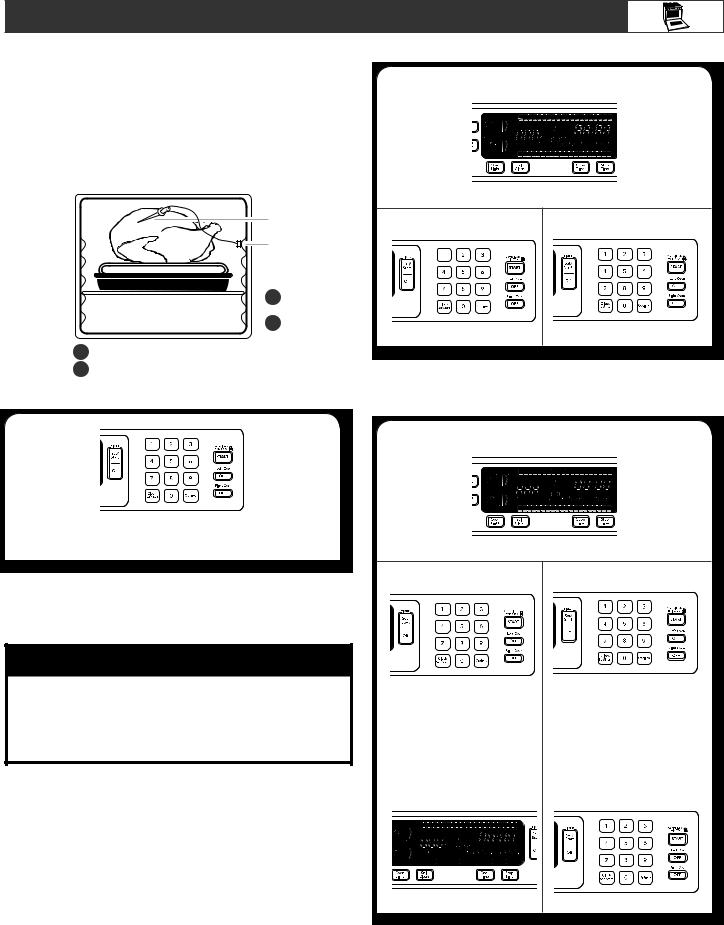
USING YOUR OVEN
Before Using Temperature Probe:
■■ Remove any racks above the food that are not in use.
■■ Insert the probe into the food item. For meats, the probe tip should be located in the center of the thickest part of the meat and not into the fat or touching a bone.
■■ Place food in oven and connect the temperature probe to the jack.
■■ Keep probe as far away from heat source as possible. Close oven door.
To Set a Cooking Time:
1.
Press COOK TIME.
|
|
A |
2. |
3. |
|
|
|
|
|
|
|
B |
|
|
|
|
1 |
|
|
|
|
2 |
Enter desired cook time. |
Press START. |
|
|
|
||
1 |
Temperature probe |
|
|
|
2 |
Temperature probe jack |
|
To Set a Delay Cooking Time: |
|
|
Before setting, make sure the clock is set to the correct time |
To Use Temperature Probe: |
of day. See “Clock” section. |
Enter desired probe temperature before selecting a cooking mode. The probe temperature is the desired temperature of the food when it is done.
After Cooking:
Unplug and remove the probe when removing food.
Timed/Delay Cooking
 WARNING
WARNING
Food Poisoning Hazard
Do not let food sit in oven more than one hour before or after cooking.
Doing so can result in food poisoning or sickness.
Timed Cooking allows the oven(s) to cook for a set length of time. Delay Cooking allows the oven(s) to be set to turn on at a certain time of day. Delay start should not be used for food such as breads and cakes because they may not bake properly.
Timed Cooking is available on most cycles including: Bake, Convect Bake, Convect Roast, EasyConvect™ Conversion, Bread Proof, and Keep Warm.
Delay Cooking is available on the Bake, Convect Bake, and Convect Roast cycles.
NOTE: For best cooking results, when the temperature probe is being used, the Cook Time function cannot be used.
1.
Press COOK TIME.
2. 4.
|
|
|
|
|
|
|
|
|
|
|
|
|
|
|
|
|
|
|
|
|
|
|
|
|
|
|
|
|
|
|
|
|
|
|
|
|
|
|
|
|
|
|
|
|
|
|
|
|
|
|
|
|
|
|
|
|
|
|
|
|
|
|
|
|
|
|
|
|
|
|
|
|
|
|
|
|
|
|
|
|
|
|
|
|
|
|
|
|
|
|
Enter desired stop time. The |
|
|||||||
Enter desired cook time. |
|
|
|||||||||||||||||
|
|
|
|
|
|
|
|
|
|
|
start time is automatically |
|
|||||||
|
|
|
|
|
|
|
|
|
|
|
calculated. When the start |
|
|||||||
|
|
|
|
|
|
|
|
|
|
|
time is reached, the oven |
|
|||||||
|
|
|
|
|
|
|
|
|
|
|
will automatically turn on. |
|
|||||||
|
|
|
|
|
|
|
|
|
|
|
When the stop time is |
|
|||||||
|
|
|
|
|
|
|
|
|
|
|
reached, the oven will shut |
|
|||||||
|
|
|
|
|
|
|
|
|
|
|
off automatically. |
|
|||||||
3. |
|
|
|
|
|
|
5. |
|
|
|
|
||||||||
|
|
|
|
|
|
|
|
|
|
|
|
|
|
|
|
|
|
|
|
|
|
|
|
|
|
|
|
|
|
|
|
|
|
|
|
|
|
|
|
|
|
|
|
|
|
|
|
|
|
|
|
|
|
|
|
|
|
|
|
|
|
|
|
|
|
|
|
|
|
|
|
|
|
|
|
|
|
|
|
|
|
|
|
|
|
|
|
|
|
|
|
|
|
|
|
|
|
|
|
|
|
|
|
|
|
|
|
|
|
|
|
|
|
|
|
|
|
|
|
|
|
|
|
|
|
|
|
|
|
|
|
|
|
|
|
|
|
|
|
Press STOP TIME. |
Press START. |
21
